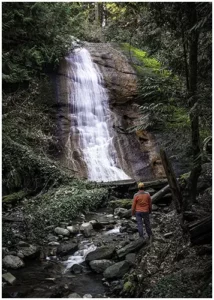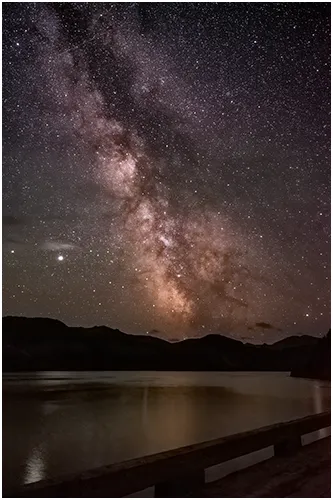
The Charming Northfield Falls in the Heart of Beach Estate Park
Looking to kill off an hour while in Nanaimo, BC? Just a short hop-skip and


Have you ever gazed up at the night sky, wondering if you could capture the beauty of the Milky Way in a photograph? Prepare to embark on a night-journey with your camera in hand, as we unveil the secrets of Milky Way photography. Picture this: a tapestry of stars strewn across the velvety expanse, waiting for your lens to immortalize. In this guide, we’ll explain the secrets of settings, gear, and techniques that will help you capture the beauty of the Milky Way. Get ready to master Milky Way photography and make the night sky your canvas!”
Milky Way photography allows you to capture awe-inspiring images of our home galaxy. Shooting millions of far-off stars with your camera, you’re often left with a sense of wonder. For instance, imagine capturing the Milky Way’s, densely packed with stars whose light seems to merge from our planet’s perspective. It’s simply dazzling!
A DSLR or mirrorless camera is critical for shooting the Milky Way. They provide high-resolution photos superior to most smartphones.
| Pros | Cons |
|---|---|
| Stellar high-resolution images | Can be expensive |
| Optimal light collection with Full Frame sensor | Requires a steep learning curve |
| Improved low-light shooting with high ISO | Regular maintenance is needed to keep gear in top shape. |
| Can withstand various weather conditions | Heat dissipation issues can be problematic in older models. |
| Convenient built-in intervalometer (bulb) | Potential limitation in lens compatibility |
Understanding how to photograph the Milky Way requires the right gear. Top on my list? A fast wide-angle lens!
Here are 5 pros:
Conversely, it has some drawbacks:
Simply put, your tripod is your silent but vital partner in capturing the Milky Way. This sturdy three-legged stand is essential to keep your camera firmly planted during those long 10-15-20-30 seconds exposures. Without it, those stellar images will be marred by blurs and shakes.
So, what makes a good tripod for this celestial pursuit?
| Pros | Cons |
|---|---|
| No camera shake, for sharper images | Could be too heavy to carry around |
| Allows long exposure time | Some lose stability in windy conditions. |
| Paves way for remote shutter activation | High quality carbon fibre tripods are expensive. |
| Can support a variety of cameras | Setting up takes time. |
| Offers best shooting angles with ballhead type |
Let’s shed some light (haha) on a must-have tool in your kit: a trusty flashlight or headlamp. Picture this: you’re out in the dead of night, setting up your gear under the starlit sky. A reliable light source becomes your only way to see. It helps you navigate all the buttons, dials, and settings without fumbling, well minimizing fumbling. Your flashlight allows you to work swiftly and confidently.
Lens filters can be a game-changer or a nuisance in your Milky Way photography. They’re essential for battling light pollution and enhancing your final image. Key features include:
| Pros | Cons |
|---|---|
| Enhances image quality despite poor lighting conditions | Might introduce colour casts in undistorted areas |
| Allows for shooting in light-polluted areas. | Not necessary for a pristine, dark sky, and I mean dark sky, something you get in Africa. |
| Broadband filters can capture natural star colours | Potential loss of some light |
| Usually compatible with various setups | Quality varies among brands |
When capturing the beauty of the Milky Way, a high ISO value is crucial. The term “ISO” in photography describes how sensitive your camera’s sensor is to light. Here’s why it’s important:
When shooting the Milky Way, long exposure times play a critical role. You need to let in enough light without creating star trails, those bright streaks showing star movement. Adjusting your camera settings for long exposure is essential. Here’s the drill:
Using a tripod for Milky Way photography is critical. Its job is to offer steady support, ensuring blur-free, sharp images. Here’s how to set it up:
Remember, a reliable tripod isn’t optional for great Milky Way photography. It’s a must!
If you can, I always give autofocus a try first. Let your camera do the work. If it can lock onto the stars, then do it. Once focus has been set, change to manual this way the lens will not go into a hunting mode later on in the evening. No need to fuss; simply tap for precise focus.
There are times when you will have to rely on manual focus. Auto hasn’t enough light to focus. AutoFocus is where you find the lens hunting back and forth. However, manual focus grants you unmatched precision. In the realm of low light, where Auto Focus can falter, Manual Focus thrives, capturing even the faintest stars.
Pro-Tip: Set the lens to infinity or sightly before. This should be the sweet spot for manual focusing.
Capture the stars like a pro with the Rule of 500 in photography. Here’s the deal: set your shutter speed to 500 divided by your focal length. Simple, right? This formula keeps the stars crisp and unsmeared. Say goodbye to blurriness and hello to tack sharp stars. Give it a try, and watch your Milky Way shots shine with captivating brilliance.”
Photographing the Milky Way is all about location, with light pollution playing a significant role. When planning to photograph the Milky Way, picking the right spot matters.
Pro-Tip: The colder the weather, the darker the sky in North America. Why? There is less moisture in the air.
Pro-Tip: 2 I’ll spend time researching locations in the Photo Ephemeris Map and Google 3D
For Milky Way photography, here are steps to find a perfectly dark sky:
Remember, finding dark skies requires planning, but it’s also a great exploratory opportunity!
The Milky Way is a vast collection of stars, planets, and cosmic wonders. From Earth, it appears as a luminous band of stars across the night sky. We’re part of this galaxy, and its beauty holds countless mysteries waiting to be photographed.
Pro-Tips: I use a program called Stellarium for researching the location of the Milky Way.
Timing is crucial for your Milky Way success.
Pros:
Cons:
Enhance Milky Way’s brilliance, reveal details, and add depth to your nightscapes through brightness and colour saturation adjustments.
“Enhance your Milky Way shots like a pro with these post-processing steps:
1. Adjusting Brightness:
2. Boosting Color Saturation:
Expert Tips:
“Banish distractions from your Milky Way shots with expert editing. Here’s how:
Expert-Tips:
Boosting picture quality during post-processing can make a world of difference in your Milky Way photography. It lets your creativity shine through, with colours popping just right, and a well-balanced brightness that highlights the best parts of the sky.
Here’s how to excel at it:
Pro-Tip: Don’t overdo saturation and vibrance more than usual, but don’t overdo contrast to avoid crunchy stars.
Add a dash of creativity to your Milky Way photography by mastering the art of post-processing. It’s not just about the equipment you use, but your imagination that makes the photos truly stand out.
Elevate your Milky Way shots with post-processing creativity. Here’s how:
Explore these techniques to transform your Milky Way captures into breathtaking cosmic art.
Selective blending in Milky Way photography involves combining different elements from multiple images to create a perfect composite photo.
Pro-Tip: Avoid complex horizon lines like trees for easy masking. Plus, using a star tracker boosts image quality but beware, it can cause a blurry foreground.
Adjusting image resolution and size. It ensures that your images maintain a high quality when viewed on different platforms.
Be sure to engage your audience, let them be in awe with your creativity that brings out the unique story within your image!
Mastering Milky Way photography is an awe-inspiring journey. With the right gear and settings, you’ll unveil the breathtaking beauty of your galaxy. Remember to choose a prime location, stay mindful of timing, and embrace post-processing to elevate your photos. So, crab your camera, head into the night, and make the Milky Way your canvas.
For Milky Way photography, use ISO settings between 1600 and 6400. This balances capturing details and minimizing noise, ensuring stunning night sky shots.
Capture the Milky Way’s brilliance during moonless nights, usually around 1–2 hours before dawn or after sunset. Optimal times vary by location and season, so research and plan ahead for the best results in your area.
To photograph the Milky Way, go to a dark and secluded place. Use a wide-angle lens and a tripod. Adjust your camera settings for a longer exposure time. Remember to focus carefully and experiment with manual settings.
Cold weather reduces moisture in the air, leading to less atmospheric distortion. This clarity enhances star visibility, making the night sky appear sharper and more vibrant.

Looking to kill off an hour while in Nanaimo, BC? Just a short hop-skip and

Photography can be a fulfilling and enjoyable hobby that brings a creative outlet to your

Welcome to our guide to Photoshop tutorials for beginners: A Complete Beginner’s Tutorial for Learning